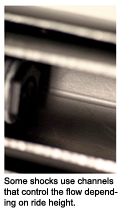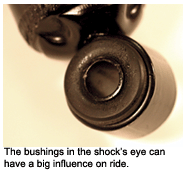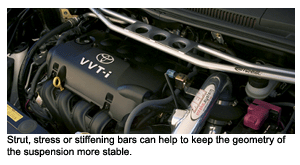In the current import market, performance-modified vehicles known as sport compacts are finding themselves equally at home at local road courses and drag strips as they are on city streets. While the most popular hot-rod imports were originally designed to squeeze the last mile out of a drop of regular gasoline, these gasoline-miserly vehicles may now squeeze astoundingly high horsepower out of their small cubic-inch engine displacements. With turbocharging boosts now breaking into the 20-psi range, and with combustion aided by generous whiffs of nitrous oxide gas, these little mini-rockets are posting elapsed times at the drag strip comparable to the huge domestic big-block engines of decades past.
Unfortunately, too many hot-rod sport compacts don’t have enough suspension upgrades to handle their muscle-car horsepower. Import specialist shops may be asked, on an increasing basis, to align, modify or fine-tune increasingly elaborate suspension systems. It’s not difficult, providing that you sell your potential customer the complete suspension upgrade!
Generating at least one horsepower per 10 pounds of vehicle weight will create handling problems due to high vehicle speeds and cornering forces. Tire performance, therefore, is critical because, without good pavement-to-tire contact, all of our high-performance aspirations will go up in rubber smoke. In the worst-case scenario, increased horsepower can push the stock chassis beyond its intended limits, creating steering and handling instability. The tires simply fail to make full contact with the pavement and the car won’t accelerate or go where it’s pointed.
Three elements of the stock suspension system, steering, springs and shock absorbers, should be modified to enhance the overall performance package. The front steering system, for example, must be capable of holding precise wheel alignment angles throughout a full 40-degree, lock-to-lock turning radius. The rear suspension system must be capable of precisely tracking with the front. And, the steering geometry must duplicate the exact camber and toe angles when turning to the left as turning to the right. In other words, if a steering arm or knuckle is bent, the camber and toe angles will be different on right and left turns.
If the car is used for road-course racing, the competition driver will always drive to the “slow” side of the steering. Consequently, a bent steering part may slow lap times because the car isn’t efficiently navigating 50 percent of the road course turns. We’ll get back to alignment later, after we discuss suspension and spring travel.
RIDING HIGH, RIDING LOW
How a suspension is designed depends upon how and where the vehicle is driven. “Street rod” imports, for example, are given the low look and may require hardware kits designed to lower the vehicle and restore correct wheel alignment. In most cases, when imports are lowered, wheel camber decreases. This causes the vehicle weight to bear on the inside edge of the tire, which causes the tire to lose contact area and suffer uneven wear characteristics.
Since low-aspect ratio performance tires are expensive, most enthusiasts prefer that the camber angle be restored to original specification or to zero degrees with the vehicle loaded. Aftermarket camber kits are designed to produce acceptable tire wear patterns, even when suspension geometry is occasionally operating beyond its intended range of travel.
Lowering vehicles also reduces suspension travel, which, in turn, can cause a rough ride if the springs are too soft and the struts or shock absorbers are too worn to dampen bumps. In all cases of reduced suspension travel, the spring rate and shock-dampening capacity of the suspension must be increased to offset the loss of suspension travel.
In stark contrast, dirt-course rally cars must have enough suspension travel to absorb severe bumps, while still providing enough suspension height to navigate rough surfaces without damaging vital undercar components. In this case, suspension height and travel become critical, with even minor improvements that may increase the speed at which the car can be driven.
Suspension height quite naturally brings us back to springs. In essence, springs are rated according to height and stiffness. A taller spring, for example, lets a chassis builder add more suspension travel, which allows the spring and shock to absorb severe bumps without damaging the car. When suspension travel is limited, higher-rate springs must be installed in order to absorb higher suspension loading. Of course, the backside to higher rates is that the suspension may become so stiff that it won’t absorb minor loading such as a washboard dirt road surface, which causes the tires to become airborne and lose adhesion.
Obviously, spring height is limited by chassis design and rate is determined by loading and average use. Springs that work well on asphalt probably won’t work as well on dirt. Consequently, consultation with spring manufacturers and experimentation are required to establish which spring height and rates are best for a particular vehicle and the use for which it is intended.
 SHOCKING TECHNOLOGY
SHOCKING TECHNOLOGY
Shock absorbers or struts have become as technical as the horsepower components under the hood. Modern shock absorbers may incorporate features like compressed nitrogen gas dampening, velocity-sensitive valving, external manual adjustability and, in some applications, electronically controlled adjustability, to mention a few.
Because there’s currently so much diversity in shock absorber design, it’s always best to consult with manufacturers for specific applications of their products. In racing applications, for example, a shock absorber may be manufactured in a “coil-over” spring design. The coil height is adjustable, as is the internal valving in the shock absorber.
 Most standard shock absorber valving tends to allow the shock to compress more easily than it will extend, which creates a smooth ride with the greatest amount of spring dampening. In performance applications, however, optimum shock dampening is combined with suspension travel and spring rate to provide the greatest amount of suspension control. Due to these three factors, the spring rate and dampening combinations become practically infinite. Professional recommendations, therefore, are invaluable, especially to establish a starting point.
Most standard shock absorber valving tends to allow the shock to compress more easily than it will extend, which creates a smooth ride with the greatest amount of spring dampening. In performance applications, however, optimum shock dampening is combined with suspension travel and spring rate to provide the greatest amount of suspension control. Due to these three factors, the spring rate and dampening combinations become practically infinite. Professional recommendations, therefore, are invaluable, especially to establish a starting point.
Imagine all four wheels aligned into a rectangular box and you’ll understand the importance of alignment to correct tire-to-road contact. In most cases, the wheels may be leaned toward the center of the box, which creates negative camber alignment. When coupled with slight amounts of body roll and tire scrub, negative camber keeps the tire tread in full contact on the road during high-speed cornering maneuvers.
 Front and rear toe angles should configure to zero under load and at speed. Unloaded and at zero speed, the toe angles may change plus or minus one degree, depending upon the effect of suspension geometry. When the front wheels are turned 20 degrees left or right, the inside wheel should lead the outside wheel by at least two degrees. This amount of “lead” is called the Ackerman Effect, which allows the inner wheel to turn in a tighter circle or radius than the outer wheel.
Front and rear toe angles should configure to zero under load and at speed. Unloaded and at zero speed, the toe angles may change plus or minus one degree, depending upon the effect of suspension geometry. When the front wheels are turned 20 degrees left or right, the inside wheel should lead the outside wheel by at least two degrees. This amount of “lead” is called the Ackerman Effect, which allows the inner wheel to turn in a tighter circle or radius than the outer wheel.
More importantly, camber angle should increase on the inside wheel and decrease on the outside wheel. Camber angles on both sides should be equal at various points throughout the turning radius. When camber angles aren’t equal, a bent steering or suspension component is usually indicated.
CHASSIS RIGIDITY
Of course, reinforcing the corners of our suspension “box” with new springs and shock dampening will increase the load on the stock chassis. At the minimum, a strut tower brace should be installed to maintain the center-to-center dimensions of the strut towers. Next, the chassis can be reinforced with various chassis stiffeners or support devices. Better still, installing a complete roll bar or cage assembly will help increase corner-to-corner strength of the chassis and body assembly.
As you may see, building all-around performance into an import car is relative to the needs and wants of the owner. Not everybody wants to drive a full-blown racecar. But most performance enthusiasts don’t want to drive a box-stock chassis, either. Although most of these needs and wants are pocketbook issues, each is part of selling the complete suspension upgrade.













